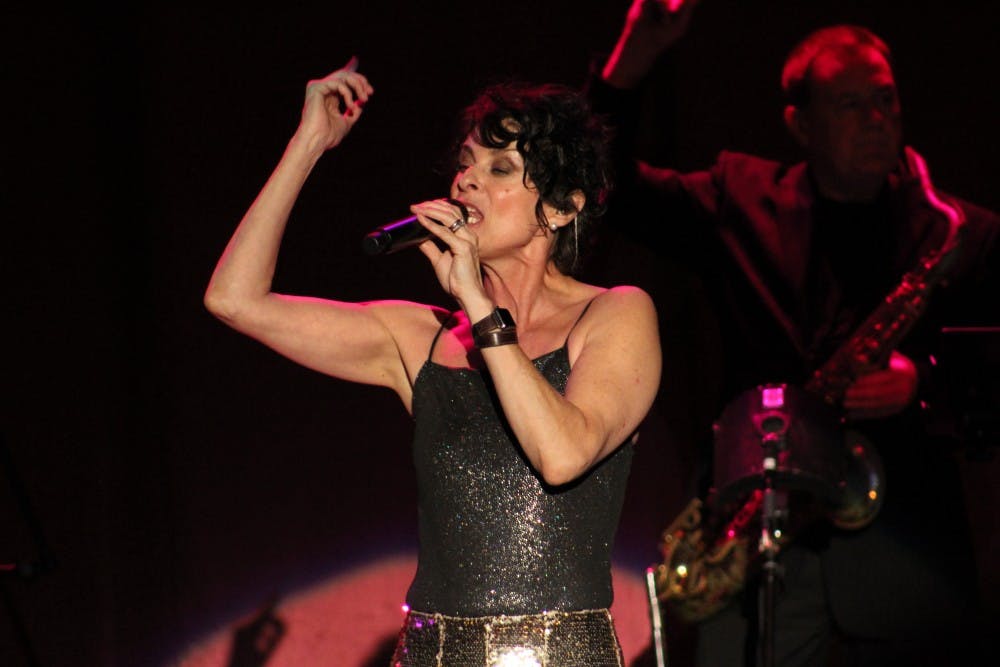Lisa Stansfield’s concert last Wednesday was a look into a slightly awkward era we’re all nostalgic for even though none of us actually lived through it. I vaguely remember listening to one or two of her songs on my parents’ weirdly sensual '80s–'90s R&B playlists on a summer night. She’s an early '90s Rhythm and Blues artist with a powerful voice and a flair for songwriting. Her sound is a slightly folksier version of what you’d get if you pitch–shifted the vocals on a Barry White track up two octaves. Her music videos, like so many others from that time period, feature non–threatening people that look like they’re about to tell you not to do drugs, and make you wonder just what the hell was going on in the '90s. Suffice to say, before going into that concert, I didn’t expect much more than an awkward performance.
Seeing her live was a completely different experience. Maybe it had something to do with the quaint, lightly crowded venue. The small, intimate setting of Keswick Theater gave her the perfect space to showcase her talent and sound as deft and formidable, just like her record. In many ways, the genre conventions of '90s R&B were holding her back. The minimal instrumentation, consisting of slow, mellow chords on that float–y, late '80s synthesizer that you’ve heard in songs by Phil Collins and a backing rhythm section that could’ve easily been composed using a simple drum machine, hid the skill behind composing and performing her music. But now, seeing her live, her vocal talent and stage presence really shone through.
The band was completely in sync: instruments and voices intermingled to form a smooth, yet rich layer of sound in which the different textures flawlessly cycled in and out. The backup singers were given enough volume to properly pay tribute to the songs’ harmonies, and the strings and keyboards worked together in a similar arrangement. Stansfield also let the backing artists shine on their own. She gave all instruments the same amount of consideration; there would be a keyboard solo on one song, and the percussionist would take the stage on the next. Every single instrument on stage, ranging from the bongos to the flute, got its time in the spotlight. And eventually, when she decided it was time, she retook control of the stage and led the song back in its set direction. Surprisingly, the more fast paced songs in the set, such as "Change," better demonstrated their finely–tuned group dynamic.
Her individual performance also went well beyond anything I listened to by her in the days leading up to the concert. The jazzy, soulful quality of her melodies was more visible when performed live. With a masterful control over dynamics and an impressive range, she dominated the stage. Her overall commanding presence let her raise the audience from their seats for her funkier, more upbeat dance ditties and sit them back down for her more gentle, soothing serenades.
What stood out to me the most, however, had nothing to do with the actual music being played. I was by far the youngest person in the crowd. The theater was filled with Gen Xers who reeked of weed and were partying like it was 1999. This wasn’t the kind of concert that you took your kids to or the kind of concert that kids would want to go to at all. This was a concert filled with people reliving their prime. Stansfield’s fans got up from their designated seats and flooded the area in front of the stage to bust out moves that I’d only ever seen in old–school music videos. They boogied and sang along to her sensual, life–affirming lyrics for her pop hits, sat down for her blues ballads, and then repeated the cycle all over again.
Almost mirroring what was going on off–stage, Stansfield would go from standing in place and dramatically singing into the microphone to ripping it off and dancing back and forth, moving the audience along with her. Her dance moves were insanely bizarre, but just as insanely enjoyable: at one point she did something that can only be described as a “cowboy dance,” where she held her hands forward, as if holding the reins on a horse, and flailed one leg to the side followed by the other, traveling backward and forward on the stage for a solid five minutes. I was impressed—and entertained.
After she closed the concert with a vaguely political song about living together, I left the theater still processing what had just happened before me. I recognized some of the sounds, movements and themes from '90s' nostalgia–fueled songs and videos, but I felt mildly out of place seeing the people who actually lived through that time un–ironically enjoying them. More than anything, though, I felt a sort of gleaming hope. I left that concert thinking about how maybe, thirty years into the future, I’ll also get the chance to boogie down with my own antiquated dance moves and sing along to the music of an artist that history left behind.







